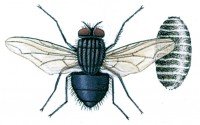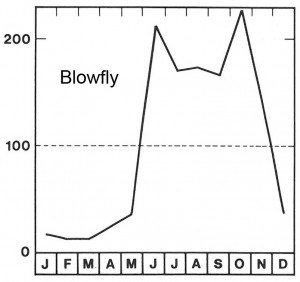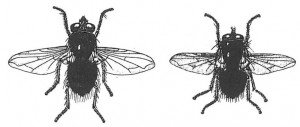

The many species of blowflies normally live in the wild. Inside you can meet the heavy, blue-black blowfly, for example the species Calliphora erythrocephala and the slightly smaller, green-metallic shiny gold flies of the genus Lucilia.
Blowflies lay their eggs, the so-called flyblow, in dead animals and other decaying organic materials (excrement, cheese, etc.). The eggs hatch less than a day after they are laid and the larvae bore their way directly into the food. They grow quickly and are only between 4 days and a few weeks to become large enough to pupate. The larvae will then leave the carrion, dig into the soil and pupate there. The pupal stage lasts 1 – 2 weeks. When it is over the adult blowflies hatch and force themselves to the surface and fly away. Adult blowflies can live for a month. You can see them suck on juicy meat and many other kinds of food. Blowflies do not have to come into direct contact with whatever, they will lay eggs on. Females can lay their eggs though a fly screen and tiny holes in plastic and let the eggs fall on the meat. Flyblow hatch and the larvae can develop as long as the temperature is higher than 6-7 ° C.

Blowflies are generally heavily contaminated with micro-organisms. On average, there are three times as many bacteria on blowflies as on house flies. It is among others the bacteria of the genus Clostridium and Salmonella. Blowflies can smell meat and carcasses at a distance of several kilometres. In industries working with things that tempt blowflies, effective measures must be taken to block them out (see page 164). Blowflies can come from birds’ nests with dead chicks or from dead mice or rats under floorboards or in attics. A single dead rat may provide feed for 4000 maggots. The maggots will, under natural conditions, dig into the soil. When this is not possible they will wander far and wide to find a suitable site for pupation. They have a tendency to seek down and away from light. In containers with meat waste that has been there for too long, you will often see mass occurrences of migrant blowfly larvae. They can in large volumes search across courtyards and find their way in through doors and down basement stairs. This mass invasion is stopped most effectively by dusting with an insecticide powder against creeping and crawling insects. The blowfly larvae are however quite persistent and can survive for several hours before they stop crawling. After the dusting it will in most cases be rational to vacuum, sweep or wash away the dead larvae. In the summer, containers with meat waste must be emptied and cleaned at least three times a week if you want to be sure not to be bothered by maggots.
For use in food companies, including fish and game stores, there are light traps, which are quite effective against blowflies.




